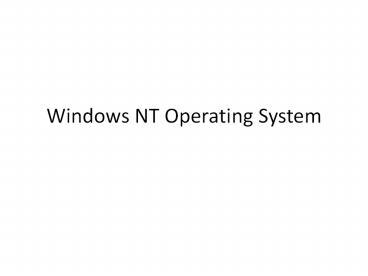Windows NT Operating System - PowerPoint PPT Presentation
Title:
Windows NT Operating System
Description:
Title: Windows NT Operating System Author: wang Last modified by: Huda Created Date: 8/23/1999 9:06:46 PM Document presentation format: On-screen Show (4:3) – PowerPoint PPT presentation
Number of Views:139
Avg rating:3.0/5.0
Title: Windows NT Operating System
1
Windows NT Operating System
2
Windows NT Models
- Layered Model
- Client/Server Model
- Object Model
- Symmetric Multiprocessing
3
Layered Model
- Application
- Program
- Application
- Program
- User Mode
- Kernel Mode
- System Services
- File System
- Memory and I/O Device Management
- Processor Scheduling
- Hardware
4
Client/Server Model
- Memory
- Server
- Client
- Application
- Network
- Server
- Process
- Server
- File
- Server
- Display
- Server
- kernel
- Send
- Hardware
- Reply
5
Windows NTs Client/Server Structure
- Win32
- Client
- OS/2
- Client
- POSIX
- Client
- OS/2
- Subsystem
- POSIX
- Subsystem
- Win32
- Subsystem
- Executive
- Kernel
- Hardware
6
Object Model
- An object is a data structure whose physical
format is hidden behind a type definition. It
embodies a set of formal properties and is
manipulated by a set of services. - Windows NT uses objects to represent system
resources. - Any system resource that can be shared by more
than one process is implemented as an object and
manipulated by using object services.
7
Symmetric Multiprocessing
- Memory
- Processor A
- Processor B
- User
- Thread
- Operating
- System
- User
- Thread
- User
- Thread
- User
- Thread
- Operating
- System
- I/O Devices(Monitor,Mouse,Keyboard)
8
Asymmetric Multiprocessing
- Memory
- Processor A
- Processor B
- User
- Thread
- User
- Thread
- Operating
- System
- User
- Thread
- I/O Devices(Monitor,Mouse,Keyboard)
9
Windows NT Structure
- The structure of Windows NT can be divided into
two parts - The user-mode portion of the system(the Windows
NT protected subsystems) and - The kernel-mode portion(the NT executive).
10
Windows NT Structure
- Windows NT servers are called protected subsystem
because each one resides in a separate process
whose memory is protected from other processes by
the NT executives virtual memory system. They
communicate with each other by passing messages. - The NT executive is capable of supporting any
number of server processes. The servers give the
NT executive its user and programming interfaces
and provide execution environments for various
type of applications.
11
Protected Subsystem
- Windows NT has two types of protected subsystems
- Environment subsystem
- Integral subsystem
12
Environment subsystem
- An environment subsystem is a user-mode server
that provides an API specific to an operating
system. - When an application calls an API routine, the
call is delivered through LPC facility to the
environment subsystem. - The environment subsystem executes the API
routine and returns the result to the application
process by sending another LPC. - The most important environment subsystem in
Windows NT is Win32 subsystem.
13
Integral Subsystems
- The remaining protected subsystems, the integral
subsystems, are servers that perform important
operating system functions. - One of them is security subsystem, which runs in
user mode and records the security policies in
effect on the local computer. - Several components of the Windows NT networking
software are also implemented as integral
subsystems.
14
Executive Components
- Object Manager
- Security Reference Manager
- Process Manager
- Virtual Memory Manager
- I/O and File System
- Kernel
- Hardware abstraction layer(HAL)
15
Windows NT Design Objectives
- Extensibility
- Backoffice Suite (SQL Server,
Exchange,..etc.) - Portability (from one hardware to another)
- Written by C, which is not hardware
dependent - Compatibility
- DOS, Win16, Win32 and POSIX (Portable
Operating System Interface based on UNIX)
Compatible. - Security
- Security logon, Discretionary access control,
Audit, Memory protection - Performance
- Reliability and Robustness
16
Extensibility
- Protected subsystems
- Modular Structure
- Object representation of resources
- Loadable drivers
- RPC facility
17
Portability
- Portable C
- Processor isolation
- Platform isolation
18
Reliability
- Structured exception handling
- Modular design
- New NT file system
- C2 security architecture
- Virtual memory
19
Compatibility
- Program compatibility
- File System compatibility
20
Windows NT Features
- Networking components
- NetBEUI, IPX/SPX, TCP/IP, DLC, ApplTalk,
PPTP, VLAN - Internet/Intranet components
- Internet Information Server (IIS), FTP
server, gopher server. - Interoperability components
- Clients DOS, Windows95/98, Windows NT
workstation, Macintosh. - Application-Enabling components
- Support Inter Process Communication (IPC)
- Administrative components
- Primary domain controller, backup domain
controller, or standalone. - Workstation components
- A NT server can also be used as a
workstation.
21
Starting your Windows NT
- Windows NT is strong in Security, performance,
stability, and networking, but ease of use and
hardware configuration is not as good as Windows
95 - Notes Install Windows
- Hardware Selection Hardware Compatibility List
(HCL) - Choosing a File System NTFS or FAT
- Choosing a Domain Role (PDC, BDC, Member sever)
- Tips Microsoft strategy
- Windows 98/ NT Workstation take place of Windows
95 - NT Server compete with Unix
22
Conclusion
- Windows NT is a symmetric multiprocessing
operating system which support multiple operating
system environments. - It has a Windows graphical user interface and
runs Win32, 16-bit Windows, MS-DOS, POSIX, and
OS/2 program. - It employs advanced operating system principles
such as virtual memory, preemptive multitasking,
structured exception handling, and operating
system objects. - It is secure, powerful, reliable, and flexible.































